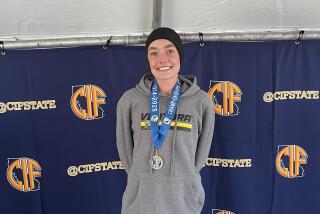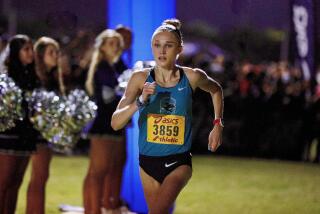Junior Colleges Add Numbers to Cross-Country Championships
- Share via
The California Community College Commission on Athletics is hoping that bigger means better when it comes to the state cross-country championships that will be held in November at Fresno’s Woodward Park.
The commission voted in May to enlarge the size of the fields at the state meet from 10 to 28 teams in the men’s and women’s races, with as many as 55 additional runners advancing as individuals not on a qualifying team.
A maximum of 30 individuals qualified for the state meet in previous years.
The change will more than double the size of the fields in the state meet (from a maximum of 100 to a maximum of 251), and eliminate the Southern and Northern California regionals.
In previous years, the top five teams in each region and the top 15 individuals among the top 35 finishers not on a qualifying team advanced to the state championships. Under the new format, 14 teams from each region will advance to the state meet.
The winning team of the five conferences in Southern California will automatically qualify for the state meet, and nine teams will be given at-large berths.
In Northern California, the winners of the six conferences will be given automatic berths with eight teams gaining at-large entries.
Antelope Valley Coach Mark Covert is a proponent of the new format because it will give smaller-school teams--such as his own--a better chance at qualifying for the state championships.
“In recent years, the state meet has turned into a case of the haves and the have-nots,” Covert said. “It seems like every year there are three or four teams from each region who always make it, and only occasionally does a new team pop into the picture.
“The new format will give some of the have-nots a chance to compete in the state meet. They might get blown out once they get there, but at least they’ll have a chance to take part in it. That’s something that couldn’t be said before.”
While some coaches from Northern Californian schools are opposed to the new format because it will allow more of the traditionally stronger teams from Southern California into the meet, it is doubtful that it will be changed in the future because it is economically more feasible to forgo the regionals.
Moving up: In a move long overdue, Adams State College in Colorado will compete at the NCAA Division II level starting this fall. Adams State dominated the National Assn. of Intercollegiate Athletics men’s cross-country championships from 1979-89, winning 10 of 11 titles. The Indians finished second to Lubbock Christian and its Kenyan contingent in 1990 and ’91.
Peter De La Cerda, a former standout at Granada Hills High who finished 20th for Adams State as a freshman in last year’s NAIA cross-country championships, is looking forward to competing at the Division II level, but he said Coach Joe Vigil will miss the NAIA. “He wanted to try and beat Lubbock Christian,” De La Cerda said. “He would like to have had one more shot at the Kenyans.”
Fast facts: Marion Jones’ dominance of the all-time national high school list in the girls’ 200 meters is becoming more impressive with every meet. On Sunday, the Thousand Oaks High sprinter timed a meet record 22.94 seconds to win the 200 in The Athletics Congress Junior (age 19 and under) championships at Ohio State.
The top two finishers in each event qualify for the U.S. team that will compete in the World Junior championships in Seoul, Sept. 16-20, if they meet or better the qualifying standards. Jones won the 100 in 11.33 on Saturday.
Jones’ 200 time was the No. 12 performance on the all-time high school list, and her eighth-fastest time this season.
Jones, 16, the national junior and high school record-holder with a time of 22.58, has run 10 of the 12 fastest high school 200 times ever, including the top five.
One out of two: Maribella Aparicio, who will be a senior at Fillmore High in the fall, and Laura Hayward, a June graduate of Agoura, placed second in the women’s 3,000 and 10,000 meters, respectively, in TAC’s Junior meet to qualify for the U.S. team.
The team will compete next month against the Canadian juniors in Winnipeg.
However, Aparicio and the Stanford-bound Hayward must run considerably faster if they are to qualify for the World Junior championships.
Aparicio, who timed a personal best of 9 minutes 55.99 seconds in the 3,000, must run at least 9:35 to qualify for the World Junior meet. Hayward, who ran 38:04.40 in the 10,000, must lower her best to at least 36:30.
Aparicio will get another chance to improve her time in the Canada-USA Junior meet, but Hayward will run in the 5,000--there is no 10,000--in that meet, and then call it a season.
Missing: Amy Skieresz of Agoura High, who placed third in the girls’ 1,600 in the state meet last month as a freshman, entered the 1,500 in TAC’s Junior meet but withdrew, citing fatigue.
Staying put: Dave Hartman won the 1991 state title in the 3,200 meters as a Canyon High senior, but he was so disappointed with his performances during his freshman season at Villanova that he considered transferring.
“My first reaction at the end of track season was, ‘God, I want to get out of here,’ ” Hartman said. “But then I started thinking, ‘It’s only your first year, maybe you should stick around a little while longer before making a decision.’ ”
Hartman, a consistent top-five runner on Villanova’s cross-country team, ran a personal best of 14:21 in the 5,000 during the indoor track season, but he never got untracked outdoors, struggling to times of 4:02 in the 1,500, 8:53 in the 3,000, and 14:54 in the 5,000.
“I felt good in the first part of all my races,” Hartman said. “But then my body would just start slowing down. I’d feel weak.”
Things got so bad that Hartman said he couldn’t complete easy six-mile runs without walking.
Hartman said a virus with symptoms similar to mononucleosis, and too much speed work early in the season led to his demise.
At Canyon, Hartman typically ran a lot of miles and did a lot of bicycling early in the season to build his strength before concentrating on speed work at the end of the season to fine-tune his fitness.
“Intervals wear me down more than some of the other guys because I’m a pretty big (distance runner),” said Hartman, who is 5-foot-11, 160 pounds. “Next year, I want to see if I can hold off on the intervals until later in the season.”
Rising star: First there was Quincy Watts, winner of three state sprint titles for Taft High.
Then came Marion Jones, who has won six state sprint titles during her first three years of high school at Rio Mesa (1989-91) and Thousand Oaks (91-92).
Now there is Michael Granville of Bell Gardens, who could be the next product of the Canoga Park-based West Valley Eagles track club to take the high school track community by storm.
Granville, 14, who graduated last month from Bell Gardens Junior High, timed a personal best of 48.79 in the 400, and ran 1:57.4 in the 800 to win those events in the youth boys’ division (athletes born in 1978 and ‘79) in TAC’s Youth Athletics championships last weekend at Auburn.
Granville, who has a personal best of 1:56.3 in the 800, could attend a high school in the San Fernando Valley, although West Valley Coach Roger Lipkis said that Granville’s parents have yet to make a decision.
Fan club: Granville is a big fan of Watts, who qualified for this year’s U.S. Olympic team with a third-place finish in the 400 in last month’s Olympic trials.
Watts, in turn, gave Granville a pair of autographed size-12 track spikes last week.
More to Read
Get our high school sports newsletter
Prep Rally is devoted to the SoCal high school sports experience, bringing you scores, stories and a behind-the-scenes look at what makes prep sports so popular.
You may occasionally receive promotional content from the Los Angeles Times.






